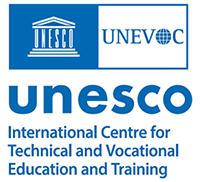
The UNESCO-UNEVOC International Centre: Who We Are | What We Do | Working With Us | Get in Touch
The UNEVOC Network: Learn About the Network | UNEVOC Network Directory
For Members: UNEVOC Centre Dashboard
Thematic Areas: Inclusion and Youth | Digital Transformation | Private Sector Engagement | SDGs and Greening TVET
Our Key Programmes & Projects: BILT: Bridging Innovation and Learning in TVET | Building TVET resilience | TVET Leadership Programme | WYSD: World Youth Skills Day
Past Activities: COVID-19 response | i-hubs project | TVET Global Forums | Virtual Conferences | YEM Knowledge Portal
Our Services & Resources: Publications | TVET Forum | TVET Country Profiles | TVETipedia Glossary | Innovative and Promising Practices | Toolkits for TVET Providers | Entrepreneurial Learning Guide
Events: Major TVET Events | UNEVOC Network News
AI refers to a variety of techniques that vary in complexity and share a common outcome: the imitation of human cognition or decision-making.
"All TVET institutions should develop an understanding of the current and future importance of AI and begin to incorporate its use into their planning. Forward thinking and, where possible, pre-emptive action, will put TVET institutions and their graduates in a position to thrive in the era of AI and contribute positively to economic, social, and individual development."
 Source:
Source:This Recommendation approaches AI systems as systems which have the capacity to process data and information in a way that resembles intelligent behaviour, and typically includes aspects of reasoning, learning, perception, prediction, planning or control.
Simulation of human intelligence processes by machines, in particular by computer systems. These processes include: learning (the acquisition of information and rules for using the information); reasoning (using rules to reach approximate or definite conclusions); and self-correction.
 Source:
Source: ILO, Changing demand for skills in digital economies and societies: Literature review and case studies from low- and middle-income countries. (Glossary on pp. 12-13), 2021
ILO, Changing demand for skills in digital economies and societies: Literature review and case studies from low- and middle-income countries. (Glossary on pp. 12-13), 2021
A general-purpose technology that enables and supports the application of many other technologies. A distinction is made between general AI and narrow AI. A general AI system is intended to be a system that can perform most activities that humans can do; according to experts, it is still far from being realised. A narrow AI system can perform just one or a few specific tasks; the AI systems that are deployed currently are narrow AI. Narrow AI uses machine learning and deep learning tools to extract information from an enormous amount of data and to generate new value based on models built with those data; it has many fields of application.
Artificial Intelligence in education refers to the application of artificial intelligence (AI) for supporting student learning outcomes or facilitation of educational goals, including educational administration. AI refers to the capacities of computing systems to perform cognitive tasks associated with human minds. As such AI may cover a range of technologies and methods, such as machine learning, natural language processing, data mining, neural networks or an algorithm.
Ability of a machine to use algorithms to analyse their environment, learn from data and use what has been learnt to take actions and make decisions – with some degree of autonomy – to achieve specific goals.
 Source:
Source: Cedefop, Glossary. Terminology of European education and training policy, (accessed 03/2023)
Cedefop, Glossary. Terminology of European education and training policy, (accessed 03/2023)
AI refers to machine-based systems that can, given a set of human-defined objectives, make predictions, recommendations, or decisions that influence real or virtual environments. AI systems interact with us and act on our environment, either directly or indirectly. Often, they appear to operate autonomously, and can adapt their behaviour by learning about the context.
AI can be defined as “automation based on associations.” When computers automate reasoning based on associations in data (or associations deduced from expert knowledge), two shifts fundamental to AI occur and shift computing beyond conventional edtech: (1) from capturing data to detecting patterns in data and (2) from providing access to instructional resources to automating decisions about instruction and other educational processes. Detecting patterns and automating decisions are leaps in the level of responsibilities that can be delegated to a computer system. The process of developing an AI system may lead to bias in how patterns are detected and unfairness in how decisions are automated. Thus, educational systems must govern their use of AI systems.
 Source:
Source: